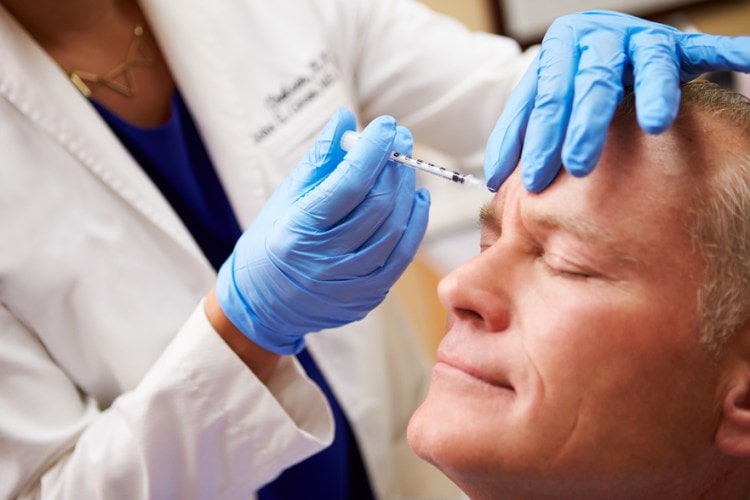Is getting Botox whilst on antibiotics safe?
Many people have been asking this question because botulinum toxin (Botox) injections are a trendy way to reduce wrinkles. Doctors also use this neurotoxic protein in the treatment of other disorders, such as excessive sweating, spasticity, migraines or neuralgic pain. Here is an evidence-based article on botox and its interactions with antibiotics.
What is Botox?
Botox (onabotulinum toxin A) is a colloquial name for botulinum toxin. It is a bacterial toxin produced by Clostridium botulinum bacteria.
It is a neurotoxic poison that blocks the release of the neurotransmitter called acetylcholine from presynaptic motor neurons on the neuromuscular junction.
A single gram of botulinum toxin can kill up to one million people (1).
It is, therefore, a hazardous substance and untreated botulism (botulinum toxin poisoning) is lethal due to paralysis of the respiratory muscles, which results in respiratory failure and death.
Some commonly used Botox containing product names are Botox, Vistabel, Dysport, Bocouture, Xeomin (botulinum toxin type A) or Myobloc (botulinum toxin type B).
How does Botox work?
There are many different types of botulinum toxin, but doctors mainly use purified botulinum toxin types A and B, which are not dangerous if used correctly.
Medical applications of Botox range from wrinkle reduction to treatment of hyperhidrosis (excessive sweating), muscle spasms, neuropathic pain, migraines, overactive bladder, etc.
Here is a brief overview of some of the most common uses of Botox in medicine.
Face wrinkle reduction
Face wrinkles are a common manifestation of aging skin. One option to temporarily reduce facial lines is getting a shot of purified type A botulinum toxin (sold under Botox, Dysport, and Xeomin brand names).
Botox blocks the transmission of anxiety between the muscles of the face and nerves, causing muscle relaxation and wrinkle smoothing (2).
Botox can also be used for other facial cosmetic procedures, such as smoothing wrinkles around the eyes, nose, lips, chin or neck, neck or jaws.
Excessive sweating and acne treatment
In addition to wrinkle reduction, Botox may also help in the management of excessive sweating (hyperhidrosis) and acne. It blocks nerve endings controlling sebaceous and sweat glands, reducing sweating and acne manifestations (3).
Botox is mostly used in the treatment of excessive armpit sweating or odor.
The injection is applied directly to the sebaceous or sweat glands and prevents the formation of sebum or sweat for about six months.
After that, it needs to be re-applied.
Prevention of migraines
Botox injections also help in the treatment and prevention of migraines, as they block the transmission of pain-transmitting nerve impulses to the brain. In the treatment of migraines and headaches, doctors will apply several Botox shots into your neck (4).
Tics, spasms, and neuropathic pain
Botox is also used to treat tics, spasms and neuropathic pains (such as trigeminal neuralgia). Neuropathic pain arises as a result of illness or nerve damage, and because Botox blocks the transmission of nerve impulses, it can be used in its treatment. The injections are applied directly to the innervation area of the affected nerve (5).
Overactive bladder
Overactive bladder is a disease that affects many people. Its symptoms are an urgent need to urinate and urine incontinence. The usual treatment is anticholinergic drugs, but if they do not work, Botox may help.
Botox injections may alleviate the activity of nerve endings that over-stimulate the bladder muscles and induce urinary urgency (6).
Strabism and blepharospasm
Muscle weakening effects of Botox may come in handy in the treatment of strabism and blepharospasm (7). The drug starts acting within a few hours, and its effects persist for several months.
How does Botox interact with antibiotics?
Many articles on the web claim that Botox does not interact with any antibiotics and its use is safe even when you take antibiotic medication.
But can you really get Botox while on antibiotics? Is it really safe?
It is not easy to answer this question.
Here is what the evidence-based medicine states.
In the 1980s, a child treated for infant botulism died after being given aminoglycoside (gentamicin) and penicillin (ampicillin) antibiotics (8).
Aminoglycosides potentiate the effects of botulinum toxin, resulting in an increased respiratory muscle paralysis, which may be lethal.
Although Botox used for medical purposes is purified and claimed to be safe, it still is a poison (botulinum toxin), so we should be careful.
In addition to aminoglycosides (gentamicin, streptomycin, amikacin, tobramycin, neomycin, etc.) botulinum toxin type A (purified neurotoxin complex) also interacts with lincosamides (lincomycin), polymyxins, aminocyclitols (spectinomycin), and tetracycline antibiotics (such as minocycline and tetracycline) (9, 10).
These antibiotics enhance the effects of Botox (e.g. muscle paralysis due to blockade of acetylcholine release from presynaptic neurons).
Therefore, they increase the risk of respiratory muscle paralysis and muscle weakness.

Botox injections are very popular but you should not get one while taking antibiotics
Botox can also interact with other drugs, especially drugs that affect neuromuscular transmissions, such as myorelaxants and other neuromuscular blocking agents (anectine, arduan, pipecuronium, atracurium, etc.).
On the other hand, taking antibiotics with Botox treatment is sometimes required (11).
For example, when using Botox in the treatment of overactive bladder, the patient takes selected antibiotics prophylactically before and after getting a Botox injection to detrusor muscle (the muscle responsible for bladder emptying).
Therefore you should always inform your doctor about any antibiotics or medicines you take before getting a Botox shot.
Also, you should not get Botox whilst taking antibiotics that do not normally interact with it (such as amoxicillin, doxycycline, clindamycin, penicillin, etc.).
Before you can get a Botox injection, you should finish your antibiotic treatment for inflammation or other diseases first.
Side effects and adverse reactions to Botox
In addition to interactions with antibiotics and other medications, Botox also has a variety of side effects, such as allergic reactions, rash, headache, neck or back pain, difficulty swallowing, shortness of breath, nausea, diarrhea, abdominal pain, itching, muscle weakness or loss of appetite. The injection site may become painful, red, swollen or may bleed.
Other adverse reactions to Botox include fever, cough, sore throat, flu-like symptoms, urinary tract infections, burning or painful sensation when urinating or excessive sweating in other areas than armpits.
When used for overactive bladder treatment, Botox may impair bladder emptying (e.g. switch the overactive bladder to a hypoactive one).
Other precautions to consider before getting Botox
If you are taking antibiotics or other medicines, always get a prior consent of your physician before getting your Botox shot.
Some doctors claim that if you (for instance) take antibiotics for a urinary tract infection, you may safely have Botox injected into your face for wrinkle reduction.
I disagree because your doctor prescribes you antibiotics if you have inflammation or a severe disorder, which weakens your body and immune system.
Getting a Botox injection while taking antibiotics or when you have any other underlying diseases, such as cystitis, urinary tract infections, skin inflammation, rash, flu, cancer, etc. is not a good idea as it may weaken your immune system even further and result in severe adverse reactions or issues.
Likewise, you should consult your doctor before getting a Botox injection if you are a pregnant or breastfeeding woman or if you take any contraceptive pills.
The bottom line
Botox injections are popular and commonly used.
Not only they may help reduce facial wrinkles and lines, but they also assist in the management of some other diseases, such as spasms, neuropathic pain or overactive bladder.
Because Botox is a medical drug, it may interact with other medicines, such as antibiotics (especially aminoglycosides, lincosamides and tetracyclines), muscle relaxants or anticholinergic medication.
If you are taking antibiotics or other medicines, are pregnant or breastfeeding, consult your physician before getting a Botox shot.
In general you need to wait 7 - 10 days after the end of your antibiotic treatment to get a Botox injection.
| Written by: | Michal Vilímovský (EN) |
|---|---|
| Education: | Physician |
| Article resources: | See numbered references in the article. |
| Image resources: | Stockphotosecrets.com |
| Published: | April 1, 2018 at 10:25 AM |
| Next scheduled update: | April 1, 2020 at 10:25 AM |
Get more articles like this in your inbox
Sign up for our daily mail and get the best evidence based health, nutrition and beauty articles on the web.


Ache in left arm that you should not ignore
Alkaline water dangers: why you should not drink it
How to Avoid Sleepiness While Studying?
23 Foods That Increase Leptin Sensitivity
Low dopamine (e.g. dopamine deficiency): causes, symptoms, diagnosis and treatment options
Swollen taste buds: the ultimate guide to causes, symptoms and treatment
Thin endometrial lining: causes, symptoms, diagnosis and treatment
Pimples inside nose: the complete guide
Holes in tonsils: definition, symptoms, treatment and prevention
How to deal with an ingrown hair cyst
Allegra vs. Zyrtec vs. Claritin
How to get rid of phlegm (excessive mucus) in throat? Detailed guide to medical and home remedies, symptoms and causes
What causes stomach ache after meals?
Allergy to penicillin and alternative antibiotics
Liver blood test results explained